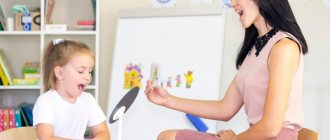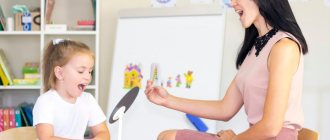Material for designing speech therapy home notebooks
Material for designing speech therapy notebooks
Speech therapy notebooks must be designed in such a way that parents understand them. Usually in a notebook I write which sounds are broken and what I am doing with them now: stage, automate or differentiate; work schedule and rules for using the speech therapy notebook.
1.
Work schedule and how to use the speech therapy notebook.
The work schedule is glued to the flyleaf so that it is easier for parents to navigate when they can approach the speech therapist.
Also, paste into a notebook or put in a folder a sheet: “How to use a speech therapy notebook,” where the following rules are written:
How to use a speech therapy notebook?
1) The notebook must be brought to each speech therapy session.
2) Homework is posted on Thursday-Friday.
3) All homework is completed for 15-20 minutes a day. Don't try to complete all tasks in one day; divide them over several days.
4) All tasks that are pasted into the notebook must begin with articulatory gymnastics.
5) Tasks must be completed every day. If they haven’t written anything to you today, you need to repeat what was asked before.
6) Don’t do your child’s homework, do it with him.
7) Teach your child to treat the notebook with care: do not wrinkle it, do not bend the sheets.
2.
Disturbed sounds and articulatory gymnastics.
A sign with broken sounds will answer parents’ questions about what you are assigning to your child, and will also remind you at each lesson what has been assigned and what needs to be assigned to the child in the future (so as not to look at the sound pronunciation screen).
Last name child's first name
| Sh | AND | H | SCH | L | L' |
A circle is placed in the bottom cells indicating what we are doing with the sound at this time.
⃝ — sound setting
⃝ — sound automation
⃝ - sound differentiation
Articulation gymnastics are also included for parents, with a precise explanation of each exercise.
Articulation gymnastics
Do this before every homework assignment.
| Smile | Smile so that your upper and lower teeth are visible. | Hold such a situation count to 10. |
| Fence | Smile widely, show clenched teeth. | Hold such a situation count to 10. |
| Proboscis | Pull your lips forward (teeth clenched) | Hold such a situation count to 10. |
| The house opens | Smile slightly, open your mouth (as for singing the sound “a”) | Hold your mouth open for 5 - 10 seconds, then close. |
| Let's punish the naughty tongue | Slap the wide flat tip of the tongue with your lips, pronounce “five-five-five” | Repeat 10 times |
| Spatula | Smile, open your mouth slightly, put your wide tongue on your lower lip. | Hold such a situation count to 10. Repeat 4-6 times. |
| Needle | Open your mouth, stick out your tongue, lower it down to your chin, make your tongue narrow. | Hold such a situation count up to 10. Repeat 4 – 6 times. |
| Coachman | Close your lips and blow hard on them. Lips vibrate and a “whoa-whoa” sound is heard | Execute 8-10 times. |
| We brush the upper teeth. We brush the lower teeth. | Open your mouth wide, smile, show your teeth. Then use the tip of your tongue to “brush your teeth” from the inside, moving it right and left (first the lower teeth, then the upper ones). The lips smile all the time, the lower jaw does not move. | Repeat 5-6 movements each in each direction |
| Let's bite your tongue | Smile, open your mouth slightly, stick out your tongue and bite, moving it back and forth. | Repeat 10 times. |
| Watch | Open your mouth slightly, stick out your tongue and move it left and right from one corner of your mouth to the other. | Repeat 5 - 8 movements in each direction. |
| Swing | Open your mouth wide, stick out your tongue and move it from the upper teeth to the lower teeth. The lower jaw does not move, the teeth do not bite the tongue. | Repeat 5 - 8 movements in each direction. |
| Slide | Open your mouth wide, smile, show your teeth. Place the tip of your tongue against your lower teeth. The back of the tongue rises up. The tongue is firm and does not “fall out” behind the teeth. | Hold in this position for a count of 10. Repeat 2-3 times. |
| The wind blows from the hill | Smile, open your mouth slightly. Place your tongue in a “slide” and then blow along the middle of the tongue. We blow on “Gorka”. | Perform 8 - 10 times. |
| Drummer. | Smile, open your mouth and tap the tip of your tongue behind your upper teeth, loudly repeating: d-d-d-d-d-d. | Repeat 8 - 10 times. |
| Delicious jam | Using the wide, flat tip of your tongue, lick your upper lip from top to bottom. In this case, the lower teeth should be visible (the teeth do not bite the tongue). | Repeat 8 - 10 times |
| horse | Open your mouth slightly, smile, showing your teeth. Click your tongue. Try not to move your lower jaw. | Repeat 10 times |
| Fungus | Suck your tongue to the roof of your mouth (as in the “Horse” exercise before clicking) | Hold for a count of 10. Repeat 5-7 times. |
| Painter | Smile, open your mouth and “paint” the hard palate (“ceiling”) with the tip of your tongue, moving your tongue back and forth. | Repeat 5 - 8 times. |
| Turkey | Open your mouth slightly, put your tongue on your upper lip and move the tip of your tongue along your upper lip back and forth, as if stroking it. Speed up the pace, turn on your voice, you hear “bl-bl” | Repeat 8 - 10 times. |
All these reminders are pasted into the notebooks for parents, only after that the homework assignments are pasted directly into the notebooks.
Map of individual work of a speech therapist teacher with preschoolers with special needs development
Previously, I posted a speech card for a speech center on the Speech Therapy Portal website.
Later, a map of the individual work of a speech therapist with preschoolers with ODD was developed, which I would like to present here.
I would be glad if it helps young professionals in their work.
| Card of individual work of a speech therapist teacher from ________________ to 20___-20______ academic year | |||
| The content of the work | holding a pose | mobility | switchability |
| Development of fine differentiated movements of the tongue and hands | |||
| Deadlines | |||
| Dynamics | |||
| Working on breathing and prosodic aspects of speech | diction | rhythm, tempo, strength | exhalation corresponds to the number of words in a phrase |
| Deadlines | |||
| Dynamics | |||
| Correction of sound pronunciation | staging | automation | differentiation |
| Deadlines | |||
| Dynamics | |||
| Correction of sound pronunciation | |||
| Deadlines | |||
| Dynamics | |||
| Development of phonemic awareness | recognition of the first sound in a word | selection of words for a given sound | differentiation |
| Deadlines | |||
| Dynamics | |||
| Lexico-grammatical structure of speech | nouns | adjectives | Verbs |
| Deadlines | |||
| Dynamics | |||
Sample of filling out an individual work card
speech therapist teacher with a child
| Card of individual work of a speech therapist teacher with Misha Ivanov for the 20 14 -20 15 academic year (sample of filling out the card) | |||
| The content of the work | holding a pose | mobility | switchability |
| Development of fine differentiated movements of the tongue and hands | teach how to hold a pose | develop mobility | train switching postures |
| Deadlines | October | november | March |
| Dynamics | — | + | + |
| Working on breathing and prosodic aspects of speech | diction | rhythm, tempo, strength | exhalation corresponds to the number of words in a phrase |
| achieve clarity of speech | Work on rhythm and tempo | develop speech breathing | |
| Deadlines | May | May | May |
| Dynamics | + | + | + |
| Correction of sound pronunciation | staging | automation | differentiation |
| staging | automation | differentiation | |
| w | w,f | sh-s, w-z | |
| Deadlines | november | December | January |
| Dynamics | + | + | + |
| Correction of sound pronunciation | l r | l r | l-l* r-r* l-r |
| Deadlines | January | February | April |
| Dynamics | + | + | + |
| Development of phonemic awareness | recognition of the first sound in a word | selection of words for a given sound | differentiation |
| learn to highlight the first sound in words | practice selecting words and pictures for a given sound | sh-s* r-r* l-r | |
| Deadlines | november | December | March |
| Dynamics | + | + | + |
| lexico-grammatical structure of speech | nouns | adjectives | Verbs |
| learn to name parts of an object, generalize, expand your vocabulary on the topic “Furniture” | learn to form possessive adjectives, expand your vocabulary | learn to form prefixed verbs, expand vocabulary | |
| Deadlines | December | February | January |
| Dynamics | — | + | + |
| use diagrams when composing sentences with prepositions | word formation and inflection | teach retelling, creative storytelling, working with diagrams, | |
| Deadlines | May | May | May |
| Dynamics | — | + | + |
Ustinenko Alla Vasilievna, teacher-speech therapist, MBDOU No. 19 “Ivushka”, Salsk
- Speech therapist documentation - Long-term plan for individual correctional and developmental work
- Long-term plan for the work of a preschool teacher-speech therapist with teachers
- Work plan of a speech therapist teacher with a young specialist
- The use of computer technologies in the work of a speech therapist with preschool children with mental retardation
- Planning the work of a speech therapist teacher in a secondary school
( 9 liked, average score: 5.00 out of 5)
Loading...





